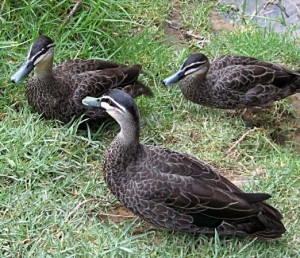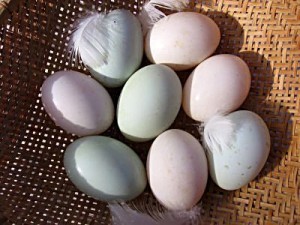Duck Raising is a one of the most profitable livestock industry in the Philippines. The most common duck that is most popularly raised locally is the Native duck or itik. Although smaller than imported breeds, they are good layers and non-sitters. Their eggs are large. Its most important product, the balut (boiled incubated duck’s egg), is sold daily throughout the archipelago for its delicious flavor and nutritive value.
Its predominant colors are black and gray. Some are barred (bulek), others are brown or have white feathers mixed with black/green. Males have coarser heads and heavier bodies than females.

Introduction:
- The availability of water for ducks for swimming does not affect much their egg laying. It does affect their food intake -they eat more when they can swim, rather than when given only drinking water.
- The size of the coop is best, if not smaller, than 3.5 sq. ft. for every duck.
- If artificial lighting is used, add 2-4 hours more daily, aside from 12 hours of natural day light.
- If natural feeds from the sea are not available (shrimps, shell or fish) give them half feed and half chicken laying mass.
- Supplementary feed like Furavin, Afsillin or Agromix may be given for egg layers.
- Ducks like wet food better than dry. It makes their eggs bigger and heavier.
- Balut made from incubator makes no difference from those produced from the mothers nest, if the eggs will be laid on the tray from 14-18 days in the incubator.
- The best length of days for making salted eggs is 19 days.
Duck Breeding
According to experts from the Philippine Council for Agricultural and Resources Research (Los Baños), the following are effective rules for duck raising:
1. Maintain the right number of ducks in every coop. One male for every 5 to 10 females. Leave only a few “extra” males in another coop to take the place of any that might die or may not be productive. The signs are:
- the male duck hisses, while a female duck quacks
- the tail of a male duck curls up
2. The male duck must be a month older than the female to make sure that they are mature for mating.
3. Select healthy ducks — good shape, good feathers, and lively eyes.
Do not get sick looking ones.

Feed for Ducks
1. Banana peelings
Researchers found that banana peelings contain more protein, fat and fibers more than does rice bran. It also contains plenty of calcium but less in phosphorus.
Method of Preparation:
- Dry in the sun for a week mud-like rotten banana peels (from the biogas digester).
- Pulverize when dried.
- Substitute this for rice bran in the proportion of 33%.
2. Cassava and Camote
According to researchers from the Visayas State College of Agriculture, feeding ducks with camote and cassava makes them produce more eggs than if they were fed with pure corn. Ducks given 20%, 30%, or 40% dried grated camote or cassava weighed the same as those given pure corn. But this is practical only in places where camote or cassava need not be bought.
3. Seaweeds
Researchers from UP Los Baños made a study on feeding ducks with seaweeds. The 45 ducks that were fed half seaweeds and half palay laid more eggs than those fed with pure palay. Because of the low cost of seaweeds (in their place) the cost of feed with 50% supplement became lower.
Source: elgu2.ncc.gov.ph; Photos: yarnivorous.blogspot.com, ozarkbantams.com